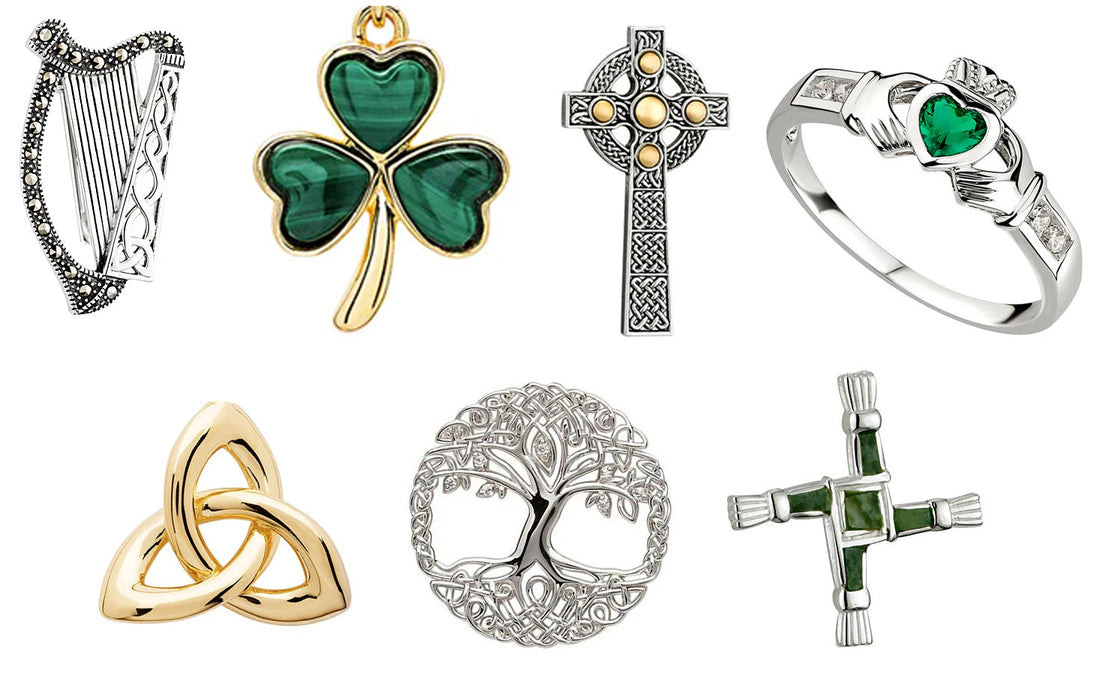A Journey Through Irish History and Mythology
Ireland is a land rich in culture, history, and symbolism, with many ancient symbols deeply rooted in Irish mythology, religion, and folklore. These symbols have been passed down through generations and are still widely recognized and celebrated today. Below is a list of some of the most popular Irish symbols and the meanings behind them.
1. The Harp
Meaning: The harp is one of the oldest and most enduring symbols of Ireland, representing Irish pride, music, and heritage.
History: The Irish harp, or Cláirseach, dates back to medieval times when it was a favored instrument of the nobility and bards. It became a national symbol of Ireland in the 16th century and is still used on the Irish coat of arms, coins, and official state documents. Its association with Irish resistance during English rule has also contributed to its significance.
2. The Shamrock
Meaning: The shamrock is a symbol of good fortune and is closely associated with St. Patrick, the patron saint of Ireland.
History: According to legend, St. Patrick used the three leaves of the shamrock to explain the Christian concept of the Holy Trinity (Father, Son, and Holy Spirit) while converting the Irish to Christianity in the 5th century. The shamrock has since become a widely recognized emblem of Irish identity, often worn on St. Patrick’s Day.
3. The Celtic Cross
Meaning: The Celtic cross is a symbol of faith and Christianity in Ireland, blending early Christian and pagan beliefs.
History: The origins of the Celtic cross are believed to date back to the early Christian period in Ireland (around the 7th century). It combines the Christian cross with a circle, which some scholars believe represents the sun or eternity. Legend holds that St. Patrick introduced the symbol, combining the Christian cross with the ancient symbol of the sun, thus helping to merge pagan and Christian beliefs. Today, it is widely seen in cemeteries and churches across Ireland.
4. The Claddagh Ring
Meaning: The Claddagh ring represents love, loyalty, and friendship.
History: This distinctive ring features two hands holding a heart, topped with a crown. It originated in the small fishing village of Claddagh, near Galway, in the 17th century. The hands symbolize friendship, the heart symbolizes love, and the crown represents loyalty. The way the ring is worn can indicate the wearer’s relationship status: on the right hand with the heart facing outward if single, on the right hand with the heart facing inward if taken, and on the left hand with the heart inward if married.
5. The Triskelion (Triple Spiral)
Meaning: The Triskelion, or triple spiral, is an ancient symbol representing movement, life, and the interconnection of the physical, mental, and spiritual realms.
History: This symbol dates back to the Neolithic era and can be found at the entrance to Newgrange, a prehistoric monument older than the pyramids of Egypt. In Celtic culture, the number three was sacred and symbolized the cycles of life, such as birth, death, and rebirth. The Triskelion continues to be a popular symbol in modern Celtic art and jewelry.
6. The Tree of Life
Meaning: The Tree of Life (Crann Bethadh) symbolizes balance, harmony, and the connection between heaven and earth.
History: In ancient Celtic culture, trees were considered sacred and believed to be the ancestors of humans, providing shelter, food, and wisdom. The Tree of Life is often depicted with branches reaching upwards, representing the heavens, and roots spreading downward, representing the earth. The symbol reflects the interconnectedness of all life and the cycle of birth, growth, and death.
7. Brigid's Cross
Meaning: Brigid's Cross symbolizes protection, fertility, and the changing seasons.
History: Brigid's Cross is associated with both the pagan goddess Brigid and St. Brigid of Kildare. Traditionally woven from rushes or straw, the cross is often hung above doors and windows on Imbolc (February 1st) to protect homes from evil and welcome the arrival of spring. The four arms of the cross are said to represent the four elements (earth, air, fire, and water) or the cycle of the seasons.
These symbols, each with its own unique history and meaning, continue to be woven into the fabric of Irish identity. From ancient times to the present day, they remain a testament to Ireland’s rich cultural heritage and its enduring connection to nature, spirituality, and the cycles of life. Whether seen on jewelry, used in art, or carried as good luck charms, these symbols remind us of the deep roots of Irish tradition and the beauty of its stories.








